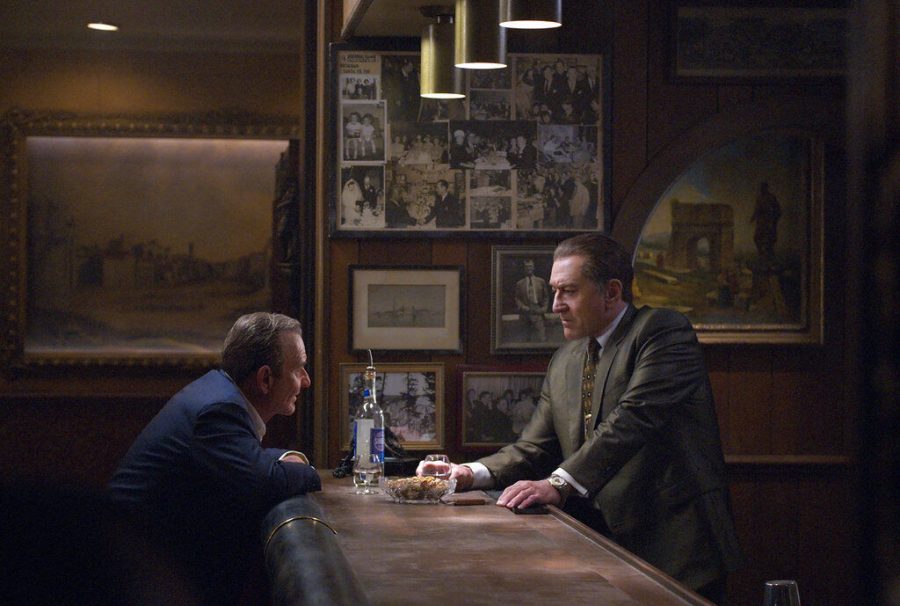‘The Irishman’ sees a return to form for Scorsese
Joe Pesci, left, and Robert De Niro star in the “The Irishman” which stars De Niro as a hitman for the Mafia.
November 30, 2019
In the past decade, Martin Scorsese has been experimenting with different genres of film, including dark comedy with “The Wolf of Wall Street,” family entertainment with “Hugo” and historical epic with “Silence.”
When Scorsese decided to make his first crime film since “The Departed,” there was much anticipation for “The Irishman,” released in theaters Nov. 1 and onto Netflix Nov. 27. The wait was worth it as “The Irishman” is a captivating epic that rivals films like “Goodfellas” and “Raging Bull.”
The film stars Robert De Niro, a frequent Scorcese star, as Frank “The Irishman” Sheeran and sees his rise through the criminal world as a hitman, eventually leading to a hostile friendship with corrupt labor leader Jimmy Hoffa, played by Al Pacino. Joining De Niro and Pacino are Scorsese regulars Joe Pesci, who came out of retirement to star in this film, and Harvey Kietel.
The performances of the cast are among the best of all actors involved. De Niro, thanks to de-aging technology, seamlessly transitions from a strong young man into a broken old man and is captivating from beginning to end.
Pacino is pitch perfect in his first collaboration with Scorsese that will leave viewers wondering why the pair hasn’t worked together sooner.
Pesci’s return to acting is more than welcome as he gives his finest performance since “Goodfellas.” As mobster Russell Bufalino, Pesci acts as a mentor to De Niro and shows him the ropes of being in the mob, which leads to an interesting friendship between the pair.
Despite being three hours and 29 minutes long, the film’s pacing is very fast even though much of the film is conversations between characters. But they’re interesting characters.
Cinema today often feels the need to keep the audience’s attention with action, which is fine sometimes, but Scorsese is content with letting De Niro and Pesci converse because they are exciting to listen to.
Steve Zaillian, who wrote the screenplay, was able to make the business of Major League Baseball a pleasure to listen to in “Moneyball” and, in “The Irishman,” he breathes new life into the gangster genre. One of the finest uses of conversation is when Hoffa and Sheeran first talk on the phone and Hoffa says “I heard you paint houses,” which is code for “I heard you kill people.”
The story is incredibly interesting and, because it’s told in flashback by an aging Sheeran, it’s unclear whether or not all of the information Sheeran tells the viewer is accurate.
This is especially clear when the film addresses the fate of Jimmy Hoffa who mysteriously disappeared in 1975 and was declared legally dead in 1982. Because of this uncertainty, the viewer questions what Sheeran says and creates a narrative of partial truth and partial fiction in “a walking contradiction.”
Scorsese is known for having made some of the most violent scenes in all of cinema including the brutal matches in “Raging Bull,” the street brawls in “Gangs of New York” and the shootout in “Taxi Driver.”
Even after all of this, the violence in “The Irishman” is still shocking and, at times, hard to watch. But, much like a gigantic trainwreck, the viewer’s eyes will remain glued to the screen.
“The Irishman”, while not as energetic as “The Wolf of Wall Street” or “The Departed,” is an achievement in filmmaking. This is the kind of film that people need to see because of how much it reflects a style of film not seen too much in the industry. As seen in the disaster that was 2018’s “Gotti,” not everyone can make a good gangster film, but Martin Scorsese obviously can.







